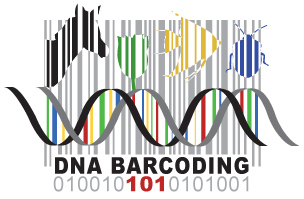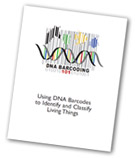
The DNA isolation and amplification methods used in this laboratory work for a variety of plants, fungi, and animals—and many products derived from them.
Your collection of specimens may support a census of life in a specific area or habitat, an evaluation of products purchased in restaurants or supermarkets, or may contribute to a larger “campaign” to assess biodiversity across large areas. It may make sense for you to use sampling techniques from ecology. For example, a quadrat samples the plant and/or animal life in one square meter (or ¼ square meter) of habitat, while a transect collects samples along a fixed path through a habitat. A “Hula Hoop” can be used as an acceptable substitute for a quadrat.
Use common sense when collecting specimens. Respect private property; obtain permission to collect in any location. Respect the environment; protect sensitive habitats, and collect only enough of a sample for barcoding. Do not collect specimens that may be threatened or endangered. Be wary of poisonous or venomous plants and animals. Consult your teacher if you are in doubt about the safety or conservation status of a potential specimen. You will also need high quality photographs of your organisms and a small sample for classical taxonomic analysis and to act as a reference sample if you plan to submit your data to GenBank®.
Do not take more sample than you need. Only a small amount of tissue is needed for DNA extraction—a piece of plant leaf about ⅛- to ¼-inch diameter or a piece of animal or fungal tissue the size of a grain of rice.
Minimize damage to living plants by collecting a single leaf or bud, or several needles. When possible, use young, fresh leaves or buds. Flexible, non-waxy leaves work best. Tougher materials, such as pine needles or holly leaves, can work if the sample is kept small and is ground well. Dormant leaf buds can often be obtained from bushes and trees that have dropped leaves. Fresh, frozen leaves work well. Dried leaves and herbarium samples are variable.
Avoid twigs or bark. If woody material must be used, select flexible twigs with soft pith inside. As a last resort, scrape a small sample of the softer, growing cambium just beneath the bark. Roots and tubers are a poor choice, because high concentrations of storage starches and other sugars can interfere with DNA extraction.
For fungi, obtain fruit bodies (such as mushrooms) when possible, as DNA is easier to obtain from fruiting bodies than mycelia. Only include multiple fruiting bodies in the same sample when they are clearly growing together and appear similar, and avoid contamination by other fungi. Fresh samples work well for DNA isolation, while dried samples give variable results. Fungal fruiting is weather and climate dependent, so their abundance will vary.
Small invertebrate animals, such as insects, can be collected whole and euthanized in a kill jar by placing them in a freezer for several hours. Samples of muscle tissue can be taken from animal foods—such as fish, poultry, or red meat. Internal organs and bone marrow are also good sources of DNA. Fresh and frozen samples, and those preserved in ethanol, work well. However, bone, skin, leather, feather, dessicated, and processed samples are challenging.
Supplies and Equipment
To share:- Collection tubes, jars, or bags
- Tweezers, scalpel, and scissors
- Smartphone with camera or digital camera with GPS (optional)
- Field guide or taxonomic key
- Organism/documentation sheet
- Pen/pencil
- Clipboard
- Ruler
- 1- or ¼-meter quadrat or similar
- Transect (measuring tape)
- Graph paper
- Collect specimens according to a strategy or campaign outlined by your teacher. "Field Techniques Used by Missouri Botanical Garden" has many good methods for collecting and preparing plant specimens.
- Use a smartphone or digital camera to photograph your specimen in its natural environment, or where it was obtained or purchased.
- Take wide, medium, and close-up views.
- Include a person for scale in wide and medium shots. Include a ruler or coin for scale in close-ups, or place specimen on graph paper with defined grid size.
- A global positioning system (GPS)-enabled phone or camera stores latitude, longitude, and altitude coordinates along with other metadata for each photo. Visualize or extract this geotag information:
- In Apple iPhoto, click "i" (image properties) to plot the photo on a map. Click "Photo," then "Show extended photo info" to find GPS coordinates.
- GeoSetter, photo metadata freeware for PCs, will plot your photo on a map.
- In Google Picasa photo editor, click "i" to find GPS coordinates.
- Your smartphone's manual should explain how to use the GPS feature to obtain coordinates.
- Many smartphones also have applications (apps) that make it easy to harvest GPS coordinates.
- Record this information along with other metadata on the organism documentation sheet, found in Resources.
- Share your collection location by dropping a pin on a Google map.
- Sign in to or create a Google Maps account.
- Create and name a new map.
- Zoom in as much as possible on the collection location.
- Click the blue pin icon to create a pin, then drag it to the location.
- Give a title to the pin, and add any collection notes in the description field.
- To add a link to a photo or other URL, click the picture icon under the “Rich text” option.
- Click "Done" to save your pin drop.
- Click "Collaborate" or "Share" to share your map with others.
- Use a field guide or taxonomic key to identify your specimen as precisely as possible: kingdom > phylum > class > order > family > genus > species. Taxonomic keys for local plants, fungi, or animals are often available online, at libraries, or from universities, natural history museums, and botanical gardens.
For example:
Plants: Tropicos (http://tropicos.org)
Animals: Integrated Taxonomic Information System (http://www.itis.gov) - Check to see if your specimen is represented in the Barcode of Life Database, BOLD (or GenBank®):
- Search by entering genus and species names in the search bar at top right. If the species is represented in the database, the "Taxonomy Browser" will list the number and sources of specimen records.
- Click on "Download Public Sequences" for a fasta file of available barcode sequences.
- Click on "Taxonomy Browser" at top left to explore barcode records by group.
- Use tweezers, scalpel, or scissors to collect a small sample of tissue.
- Freeze your sample at -20° C until you are ready to begin Part II, Isolating DNA.
If you are participating in a collaborative project, you may be asked to follow a specific procedure to document and identify your specimen.
Please be aware that details described in steps 3 and 4 may change as the devices, software, and websites develop over time.
A smartphone app can continuously record your location, making it easy to document a collection trip or a sampling transect.

 Download Protocol PDF
Download Protocol PDF